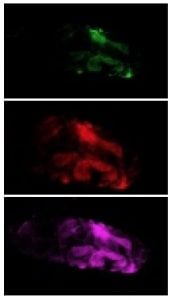 Fluorescent dyes help scientists see the inner workings of disease. In a new paper by Haiying Liu (Chem), Rudy Luck (Chem) and Thomas Werner (Bio Sci)—along with student researchers—they examine the efficacy of a rhodol-based fluorescent dye.
Fluorescent dyes help scientists see the inner workings of disease. In a new paper by Haiying Liu (Chem), Rudy Luck (Chem) and Thomas Werner (Bio Sci)—along with student researchers—they examine the efficacy of a rhodol-based fluorescent dye.
Diseases like Alzheimer’s and certain kinds of cancers affect the powerhouses of cells — mitochondria. To keep these powerhouses working efficiently, cells remove damaged mitochondria. This process, called mitophagy, is like a cell taking out the trash. In diseased cells, the garbage piles up and the cell’s pH changes. The rhodol dye responds to pH changes and glows brighter.
Luck adds that he considers it a privilege to be able to contribute to Liu’s attempts to find commercially viable probes. The team also acknowledges that the High-Performance Computer system Superior, managed under Director Gowtham, has advanced the research considerably.
Read more about the next steps of this research on the campus research blog Unscripted and celebrate National Chemistry Week with other Unscripted reads about surface chemistry, the science of brewing and mass spectrometry.